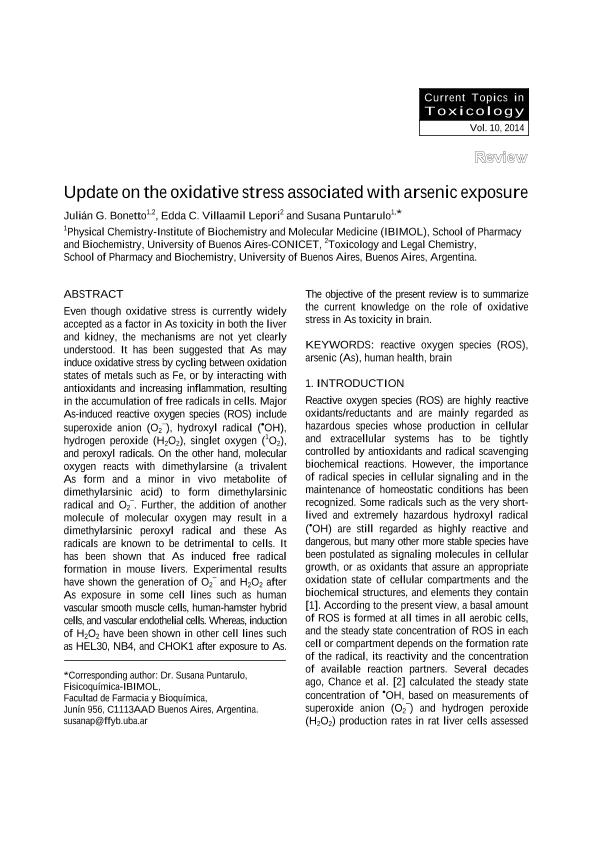Mostrar el registro sencillo del ítem
dc.contributor.author
Bonetto, Julián Gerardo

dc.contributor.author
Villaamil Lepori, Edda Cristina

dc.contributor.author
Puntarulo, Susana Ángela

dc.date.available
2017-12-15T19:06:06Z
dc.date.issued
2014-12
dc.identifier.citation
Puntarulo, Susana Ángela; Villaamil Lepori, Edda Cristina; Bonetto, Julián Gerardo; Update on the Oxidative Stress Associated with Arsenic Exposure; Research Trends; Current Topics in Toxicology; 10; 12-2014; 37-48
dc.identifier.issn
0972-8228
dc.identifier.uri
http://hdl.handle.net/11336/30797
dc.description.abstract
Even though oxidative stress is currently widely accepted as a factor in As toxicity in both the liver and kidney, the mechanisms are not yet clearly understood. It has been suggested that As may induce oxidative stress by cycling between oxidation states of metals such as Fe, or by interacting with antioxidants and increasing inflammation, resulting in the accumulation of free radicals in cells. Major As-induced reactive oxygen species (ROS) include superoxide anion (O2 −), hydroxyl radical (?OH), hydrogen peroxide (H2O2), singlet oxygen (1O2), and peroxyl radicals. On the other hand, molecular oxygen reacts with dimethylarsine (a trivalent As form and a minor in vivo metabolite of dimethylarsinic acid) to form dimethylarsinic radical and O2¯. Further, the addition of another molecule of molecular oxygen may result in a dimethylarsinic peroxyl radical and these As radicals are known to be detrimental to cells. It has been shown that As induced free radical formation in mouse livers. Experimental results have shown the generation of O2¯ and H2O2 after As exposure in some cell lines such as human vascular smooth muscle cells, human-hamster hybrid cells, and vascular endothelial cells. Whereas, induction of H2O2 have been shown in other cell lines such as HEL30, NB4, and CHOK1 after exposure to As. The objective of the present review is to summarize the current knowledge on the role of oxidative stress in As toxicity in brain.
dc.format
application/pdf
dc.language.iso
eng
dc.publisher
Research Trends
dc.rights
info:eu-repo/semantics/openAccess
dc.rights.uri
https://creativecommons.org/licenses/by-nc-sa/2.5/ar/
dc.subject
Ros
dc.subject
Arsenic
dc.subject
Human Health
dc.subject
Brain
dc.subject.classification
Otras Ciencias Biológicas

dc.subject.classification
Ciencias Biológicas

dc.subject.classification
CIENCIAS NATURALES Y EXACTAS

dc.title
Update on the Oxidative Stress Associated with Arsenic Exposure
dc.type
info:eu-repo/semantics/article
dc.type
info:ar-repo/semantics/artículo
dc.type
info:eu-repo/semantics/publishedVersion
dc.date.updated
2017-12-15T14:54:28Z
dc.journal.volume
10
dc.journal.pagination
37-48
dc.journal.pais
India

dc.journal.ciudad
Kerala
dc.description.fil
Fil: Bonetto, Julián Gerardo. Consejo Nacional de Investigaciones Científicas y Técnicas. Oficina de Coordinación Administrativa Houssay. Instituto de Bioquímica y Medicina Molecular. Universidad de Buenos Aires. Facultad de Farmacia y Bioquímica. Instituto de Bioquímica y Medicina Molecular; Argentina. Universidad de Buenos Aires. Facultad de Farmacia y Bioquímica. Laboratorio de Toxicología y Química Legal; Argentina
dc.description.fil
Fil: Villaamil Lepori, Edda Cristina. Universidad de Buenos Aires. Facultad de Farmacia y Bioquímica. Laboratorio de Toxicología y Química Legal; Argentina
dc.description.fil
Fil: Puntarulo, Susana Ángela. Consejo Nacional de Investigaciones Científicas y Técnicas. Oficina de Coordinación Administrativa Houssay. Instituto de Bioquímica y Medicina Molecular. Universidad de Buenos Aires. Facultad de Farmacia y Bioquímica. Instituto de Bioquímica y Medicina Molecular; Argentina
dc.journal.title
Current Topics in Toxicology
dc.relation.alternativeid
info:eu-repo/semantics/altIdentifier/url/http://www.researchtrends.net/tia/abstract.asp?in=0&vn=10&tid=50&aid=5556&pub=2014&type=3
Archivos asociados
